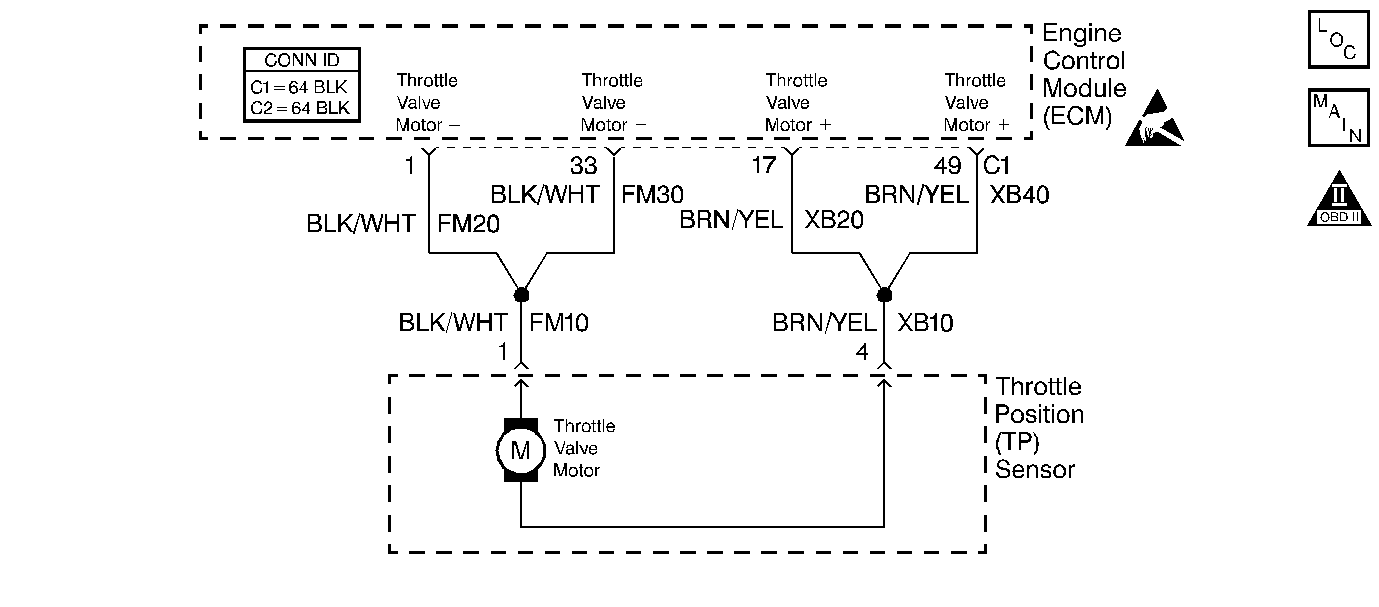
Circuit Description
The idle speed is controlled by the ECM. The ECM will command the throttle valve motor to open or close the throttle valve in order to maintain the desired idle speed.
Conditions for Running the DTC
| • | One or more of the following DTCs are not set: P0110, P0115, P0116, P0411, P0440, P0442, P0443, P0446, P0455, P0500, P1120, P1220. |
| • | The IAT is more than 0°C (32°F). |
| • | The ECT is more than 80.3°C (176.5°F). |
| • | The engine load is less than 2 percent. |
| • | The EVAP diagnostic is not running. |
| • | The EVAP is not purging. |
| • | Vehicle speed is 0 km/h (0 mph) |
| • | Secondary air diagnostic is not running. |
Conditions for Setting the DTC
The actual engine RPM is lower than the Desired Idle Speed by at least 100 RPM.
Action Taken When the DTC Sets
The ECM illuminates the malfunction indicator lamp (MIL) and records the operating conditions in the Freeze Frame on the second consecutive drive trip that the diagnostic runs and fails.
Conditions for Clearing the MIL/DTC
| • | The ECM turns OFF the MIL after three consecutive drive trips that the diagnostic runs and passes. |
| • | A History DTC clears after forty consecutive warm-up cycles in which no failures are reported by this diagnostic or any other emission related diagnostic. |
| • | The ECM battery voltage is interrupted. |
| • | The scan tool clears the MIL/DTC. |
Diagnostic Aids
Notice: Using the J 35616-A Connector Test Adapter Kit will prevent damage to the harness connector terminals.
Use theJ 35616 connector test adapter kit for any test that requires probing the ECM harness connector or a component harness connector.
Check for the following conditions:
| • | Poor connections at the ECM or at the component--Inspect the harness connectors for any backed out terminals, improper mating, broken locks, improperly formed or damaged terminals, and poor terminal to wire connection. Refer to Engine Control Module Diagnosis , Checking Terminal Contact or Wiring Repairs in Wiring Systems for the proper procedure. |
| • | Damaged harness--Inspect the wiring harness for any damage. If the harness appears to be OK, observe the scan tool while moving the related connectors and the wiring harnesses. A change in the display may help locate the fault. |
Refer to Symptoms for the Intermittents.
Test Description
The numbers below refer to the step numbers on the diagnostic table.
Step | Action | Values | Yes | No | ||||||
|---|---|---|---|---|---|---|---|---|---|---|
1 | Did you perform the Powertrain On-Board Diagnostic (OBD) System Check? | -- | Go to Step 2 | |||||||
Is the actual engine speed no greater than 200 RPM above or 100 RPM below the Desired Idle Speed? | -- | Go to Diagnostic Aids | Go to Step 3 | |||||||
3 | Is the engine RPM too high? | -- | Go to Step 4 | Go to Step 5 | ||||||
4 | Check for the following conditions:
Is the action complete? | -- | Go to Step 6 | -- | ||||||
5 | Check for the following conditions:
Is the action complete? | -- | Go to Step 6 | -- | ||||||
6 |
Does the scan tool indicate the diagnostic Passed? | Go to Step 7 | Go to Step 2 | |||||||
7 | Does the scan tool display any additional, undiagnosed DTCs? | -- | Go to the applicable DTC table | System OK |
